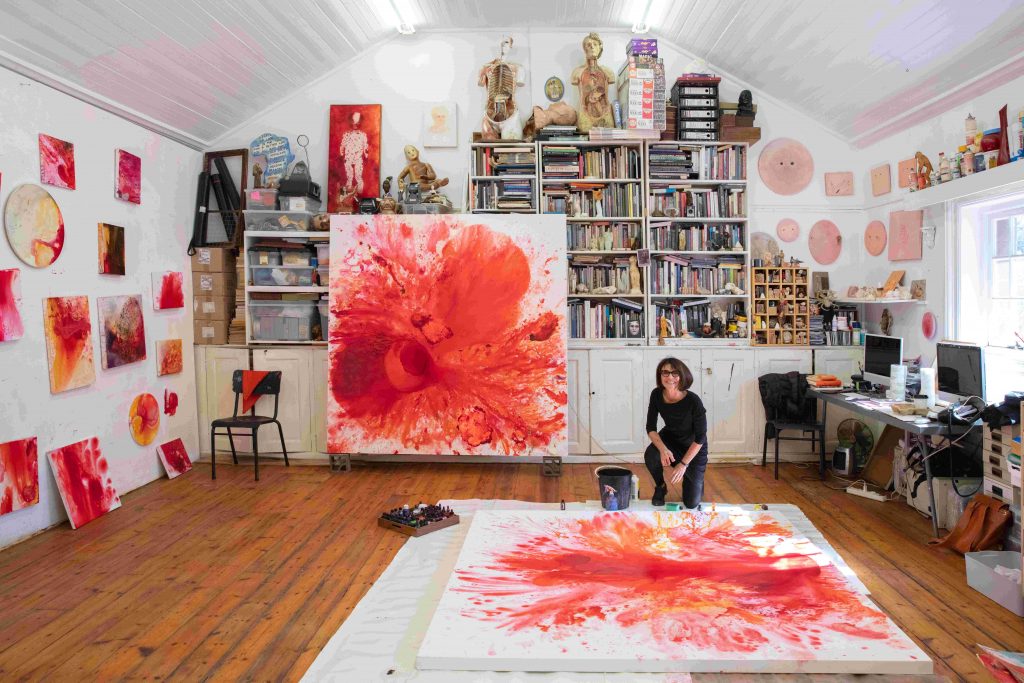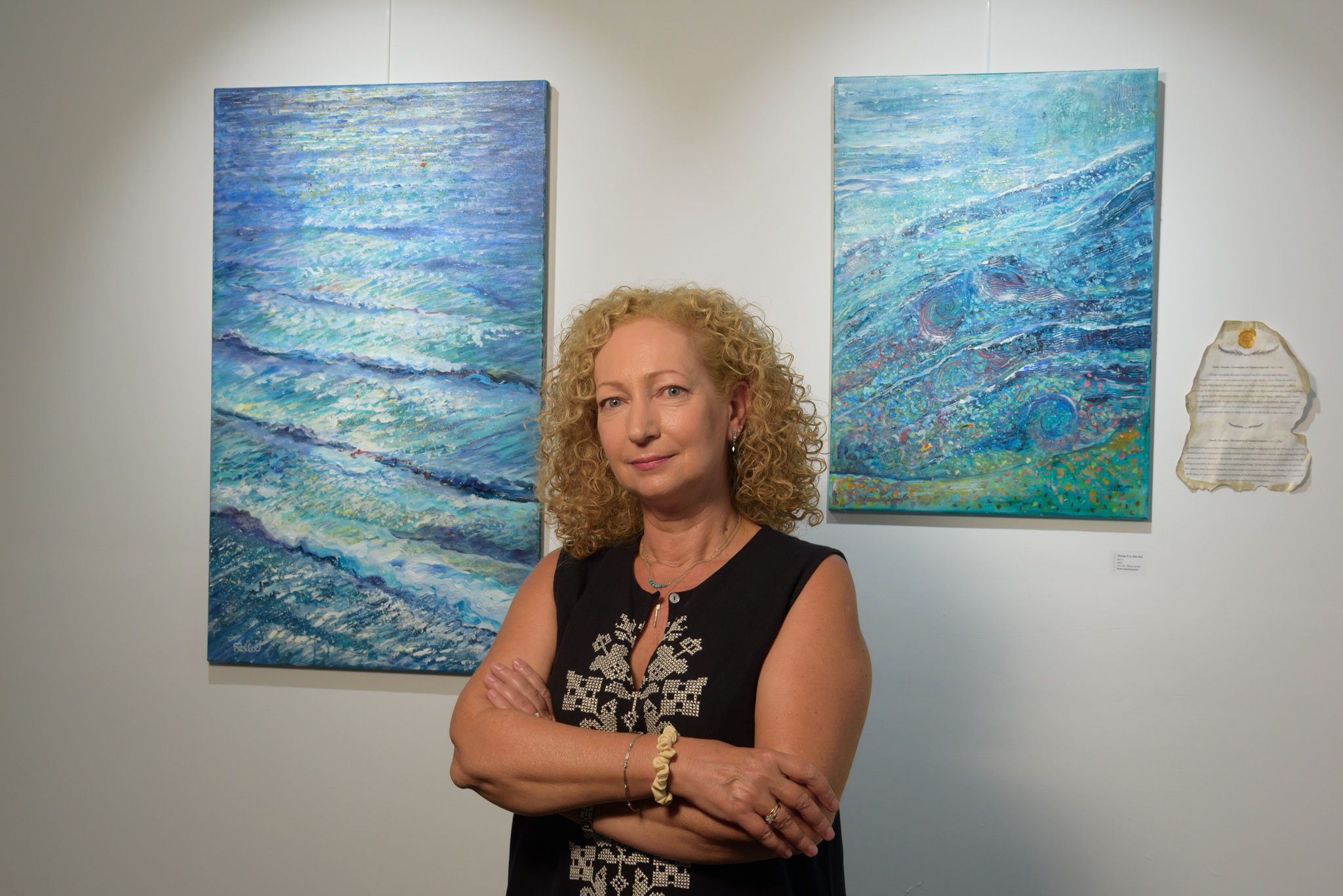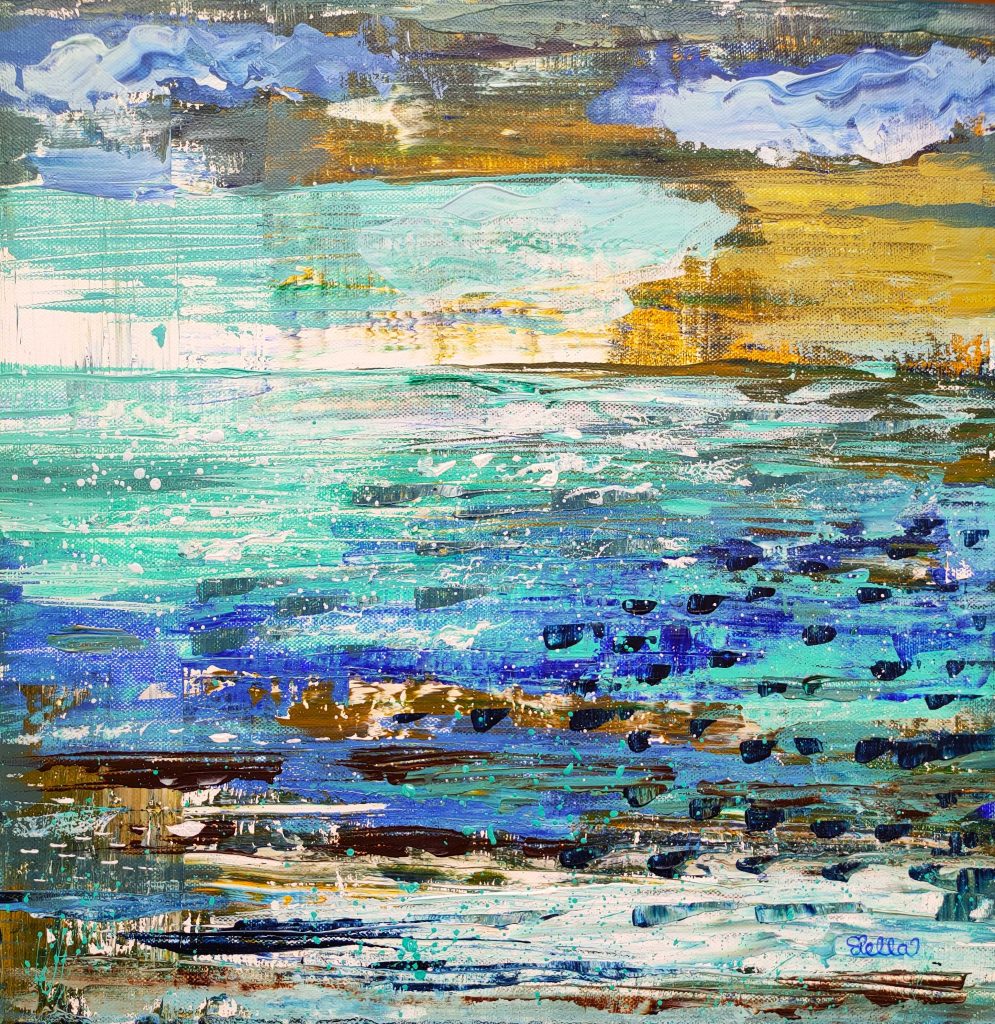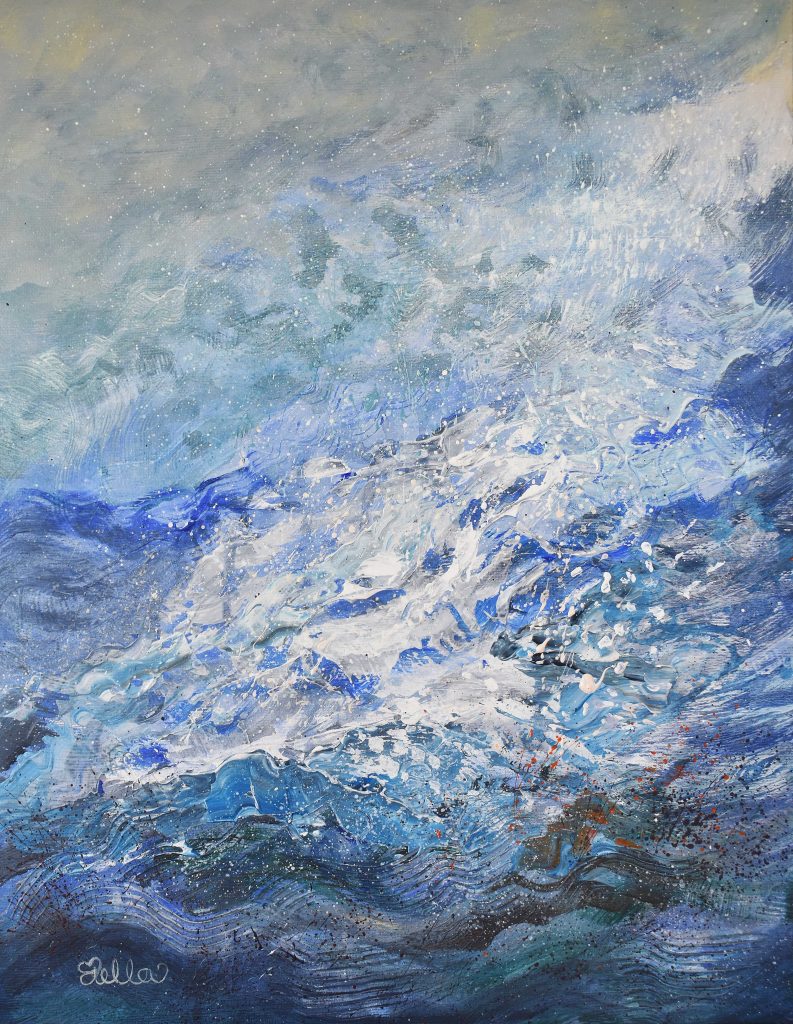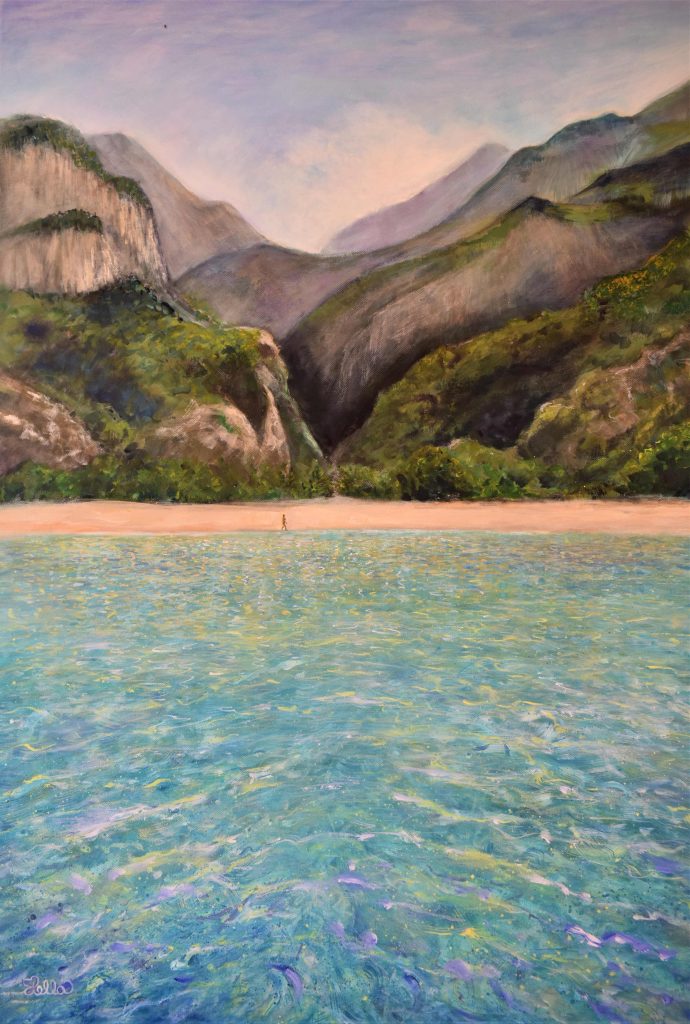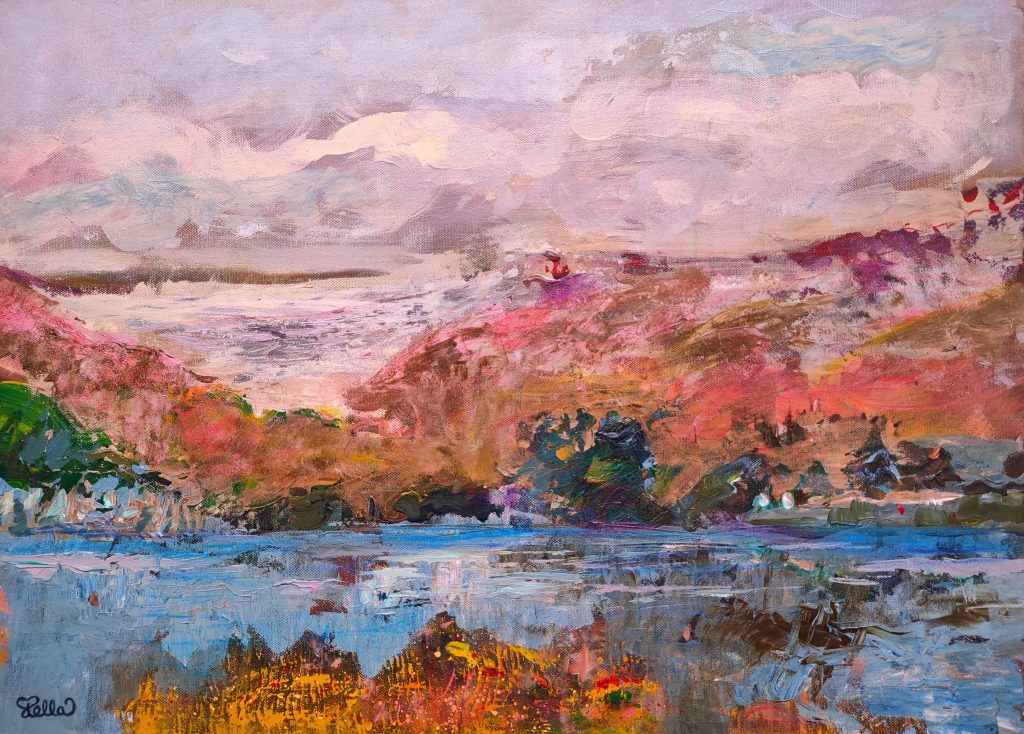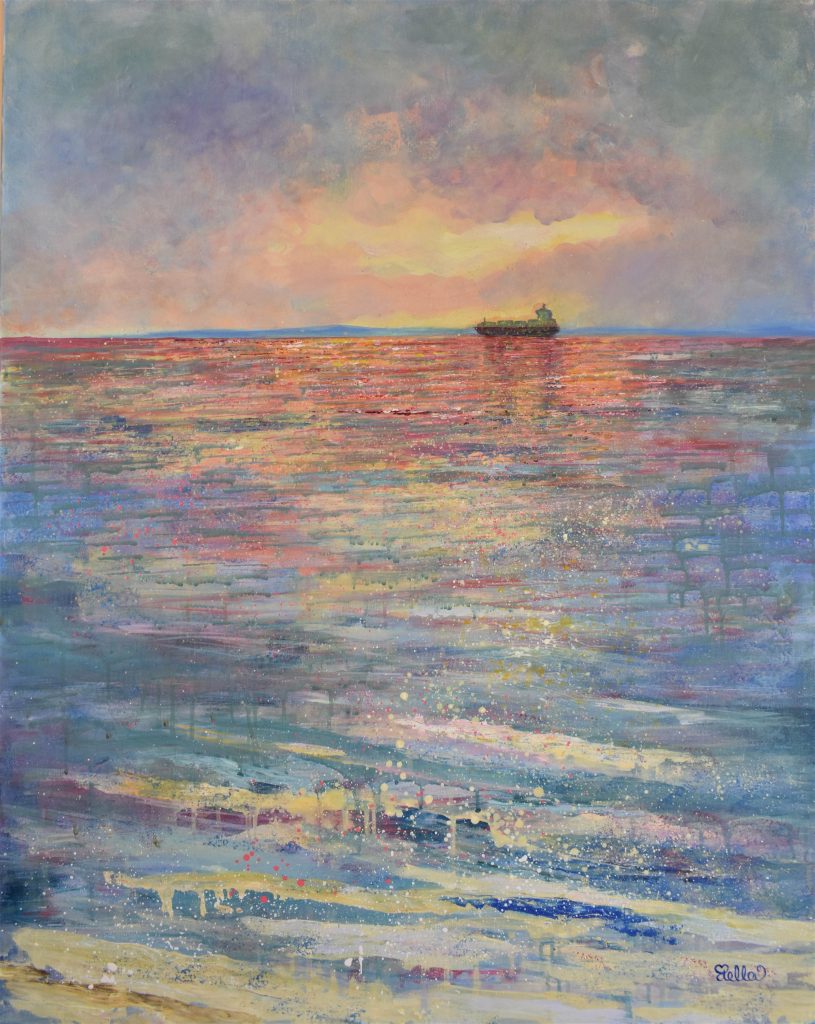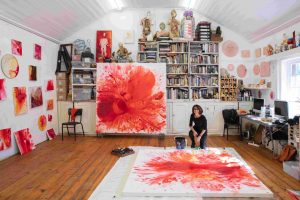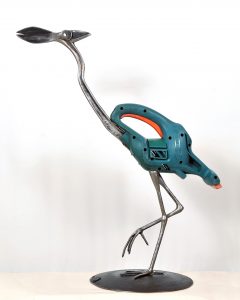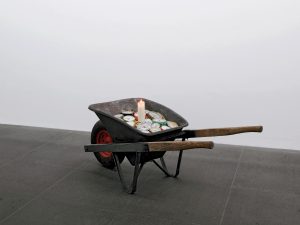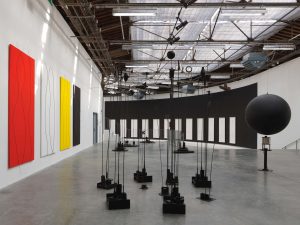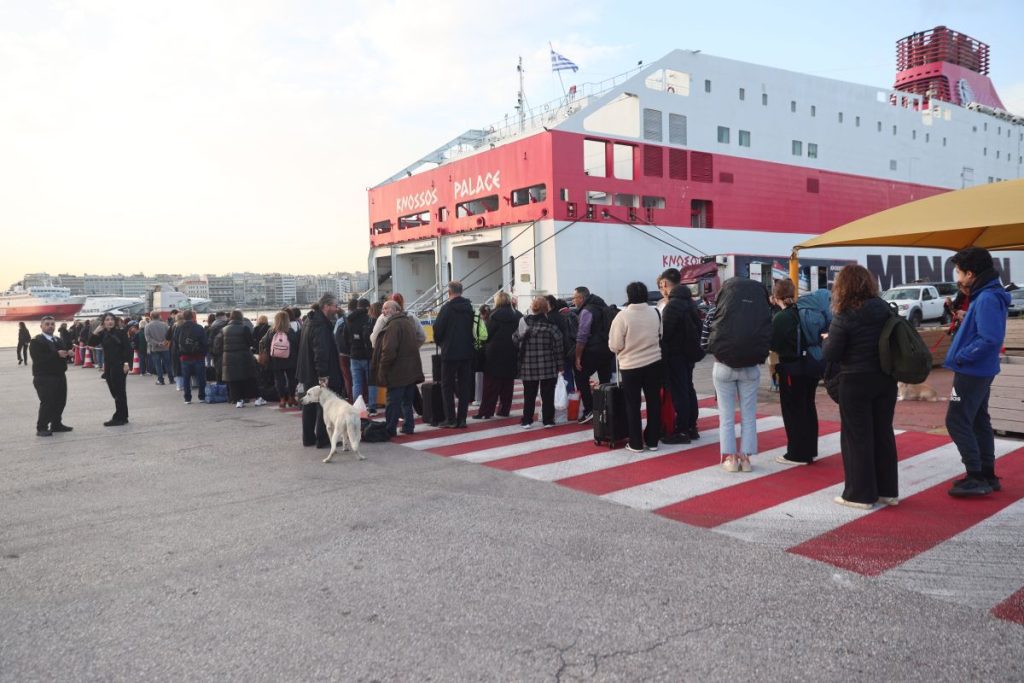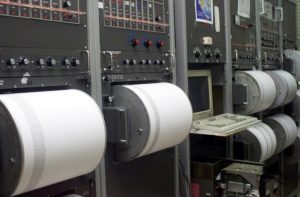“THE isles of Greece! the isles of Greece
Where burning Sappho loved and sung,
Where grew the arts of war and peace,
Where Delos rose, and Phoebus sprung!
Eternal summer gilds them yet,
But all, except their sun, is set.”
(George Gordon Lord Byron)
Here, the poetic essence of the Greek seascape unfolds across the canvas. Inspired by the verses of Byron, Cavafy, and Coleridge, Sevastopoulos – who like famed Greek artists of the past Takis and Chryssa signs her works with just her first name – transforms the Aegean into a timeless landscape of adventure, memory, and myth.
The beautiful seascapes and landscapes of her ancestral island of Samos dominated in a number of her earlier works but are still present.
Both an artist and a journalist, she studied art, English literature, and art history at Harrow College of Art, Lancaster University, and Reading University.
She has exhibited in over 30 group exhibitions, including at FokiaNou Art Space, the Tsichritzis Foundation for Visual Arts, and artzone42. In 2022, she was invited by artist Sue Tilley to exhibit in the UK and participated in the inaugural artist residency at Domus Art Gallery in Athens.
Her Seascapes series was also featured in the “Making Summer Memories” project by Vardas.
She also runs Art Scene Athens, her own website (artsceneathens.com).
After leaving your full-time job in journalism, in which you reported on arts and culture, you decided to take up your old interest in drawing and painting and devote yourself to it more intensively, if not exclusively. What were the intellectual, emotional and artistic processes and stimuli that motivated you to make such a major life course decision?
It was a combination of things, as usually is the case. I had always practiced art, even when I was a journalist, but I had kept it personal, although I had begun my studies in the field of art, at Harrow College of Art and at Lancaster University, before taking a theoretical direction (English Literature and History of Art).
There’s a time and a place for everything, and it’s never too late to do what you really want to, as long as you dedicate yourself heart and soul. Becoming a mother, and the tragic death of my mother, changed my perspective on things.
The inspiring words of other artists, my real love of practicing art, and the fact that I had finally found the time and space to really dedicate myself to my art practice all played a role. So, I decided that the time had come to dive back in!
Your current exhibition is entitled “Isles of Light and Memory – Seascapes by Stella Sevastopoulos”. The Greek islands are obviously the unifying concept and of course Greece since ancient times until this day has drawn its strength from its role as a seafaring nation. What do they symbolize for you and what was the criterion on which your choice of paintings for this exhibition was based?
We are blessed in Greece to have the most beautiful seas, with the widest range of colours: from the darkest indigos and ultramarines, to Cobalt hues and Prussian blues, dreamy turquoise and glittery greens. How can one not be inspired by the Greek sea and its islands?
Byron’s poem “Isles of Greece”, Coleridge’s “Rime of the Ancient Mariner” and Cavafy’s “Ithaca” have also inspired my seascapes. In Byron’s poem, the sea is a symbol of freedom, while Coleridge’s poem explores the Romantic Triad of nature, spirit, humanity. Cavafy’s poem on the other hand speaks of the importance of the journey, and of the return.
You have also delved into a number of ancient Greek motifs in works shown in other exhibitions. Which charm and lure you most and why?
I have looked at various ancient Greek motifs, such as the Greek meander, or a splendid reconstructed Akroterion which looks like a giant honeysuckle plant, exhibited at the Acropolis Museum.
Many Greek design motifs have been inspired by flowers and plants, such as the Acanthus plant, from which ancient architects were inspired to create the decorative motifs on columns of the Corinthian order.
I had the opportunity to explore this interest of mine when creating a series of abstract works which combined painting and engraving (on linocut), during the Domus Artist Residency entitled “Greetings from Athens”, of 2022. After taking part in this residency, I continued to explore how I could create my own motifs, and incorporate them into abstract paintings.
These new paintings were then shown elsewhere, such as at FokiaNou Art Space. My aim was never to copy the ancient Greek motifs strictly, but to be inspired by them, and to incorporate them into a more contemporary creative practice.
In this exhibition one can discern a fledgling transition from a naturalistic depiction of seascapes to a more abstract study of the water. Tell us about this ongoing process of artistic exploration.
The ‘grey zone’ between abstraction and figuration has always interested me, and sometimes I go towards the more figurative, representational or naturalistic direction, then at other times I explore more abstract paths. In fact, in the studio, I will often be working on an abstract work, but also on a more figurative work.
The usual course for most artists is to start from figuration, or naturalism, and then to explore other routes, if they want to. However even a naturalistic painting is made up of abstract elements: line, colour, shapes, tones, hues, compositional design etc. Nevertheless, I must admit that the freedom of expression that a more abstract approach to painting offers, has become all the more interesting to me at the moment. Why? Because once you are freed from the constraints of creating an illusion of reality, you can explore so many other things, such as the emotive power of colour and mark-making, and the nature of paint itself.
Water is the source of life and the expansion of civilisation to new lands, but its terrible strength can also be menacing and deadly for seafarers – from commercial sailors to navy men and migrants. You have chosen to present mostly an idyllic, peaceful and calm representation of it. Why?
There is a small work in the exhibition called “Beaufort”, which is ‘darker’ let’s say, and also the large work “Nothing But the Waves and I”, is more expressive. But yes, you are right in saying that most of the works in the exhibition present idyllic, peaceful and calm seas.
The reason for this is that I want to transmit to the viewer a bit of that peace and calm which we experience when in nature. I think that it is missing from our lives, especially for those of us living in the city. Connecting with nature’s beauty and harmony is therapeutic.
Of course, a painting can never capture that sublime beauty of nature in all its entirety. Only direct contact with nature can do that. However, it can offer a slice of it. Peaceful and calm seas are uplifting, they help us find our balance when we see them. In a world that is growing increasingly dystopian, it’s good to find some peace somewhere, even through art.
But it’s not just about painting pretty pictures. There are some other elements in there too, such as the idea of painting the increasingly diminishing ‘pockets of paradise’ still left on earth. And, in some of those paintings, there are some things lurking in those seemingly calm waters. But they are not the main focus.
Images of your ancestral land of Samos, whether seascapes or landscapes, have figured very prominently in your work. What does the island symbolize for you both in terms of seeking out roots and rediscovering romantic childhood imagery, and in terms of an artistic, adult re-exploration and redefinition perhaps of the island’s meaning for you?
Cavafy’s “Ithaca” says it all basically. I think that as a diaspora Greek, he was well aware of the importance of the ‘return’ to the motherland, or the place of one’s roots. As children, when we were living in London, we would visit Samos every summer. In fact we thought that Greece was Samos! I distinctly remember as a very young child, asking my parents “But when will we arrive in Greece?”, after landing at the old airport in Elliniko.
When I moved to Athens, in 1994, Samos remained part of the equation. It is a beautiful island, which has inspired many a peaceful seascape! It still has some ‘pockets of paradise’, untouched by commercialism, tourism, and our increasing anthropocentric interventions on the environment. And it was always a very interesting counterbalance to our lives in London. But also, to our lives in Athens. What has also intrigued me about Samos, is that it is geographically located where the West becomes the East, and at the edge of Europe.
In the past you have also delved into still-life, at times paying homage to great painters of the West like Bosschaert. Which painters have influenced you the most in your work and what have you learned from each?
Bosschaert was the ‘boss’ of flower painting! I love his delicate renditions of flowers, and have studied and have been inspired by his work, because I too love painting flowers. Flowers symbolise so many things, such as the brevity, fragility, but also the beauty of life. I think it’s the delicacy of Bosschaert’s renditions of flowers, with their dark backgrounds and memento mori tropes which appeal to me.
Other artists that have inspired me are Monet’s impressionistic use of colour and mark-making which helps capture the vitality and movement of a natural scene. Van Gogh went further, paving the way for the Abstract Expressionists. I have looked at these artists’ work too, because it has an emotive force and freedom that interests me.
It would seem that you have completely avoided the depiction of the human figure. Are there particular reasons for that?
I think it’s important to choose subjects that inspire you and interest you. My main inspiration stems from nature. However, never say never! I have, however, studied the human figure, and did life-drawing classes on a regular basis, both at art school, at university and beyond. In fact during the lockdown, I participated in the online life-drawing classes organised by Sue Tilley (artist and model for Lucian Freud, who has also written a book on Leigh Bowery).
Later on, she asked me if one of my works from those classes could be included in the exhibition “Together We Draw”, in the UK. And so, that little work of mine travelled to the UK, and resides there now! I have painted portraits, and the human figure.
In fact recently, I created some works which focus on the human face, and some which are inspired by ancient Greek busts. Maybe they will be included in an exhibition one day.
It is clear that you are rapidly transitioning from naturalist painting to the abstract, not a very easy endeavour. What has prompted you to move in this direction? In this process what have you learned about yourself as a painter and what have been the rewards of this new exploration?
I just follow my instinct and let myself explore the paths it leads me to. The key is to practice, learn, research, and to keep on going down that path of the artistic process, and to see where it takes you. It’s like a thread, which you just follow, or keep hold of. But you have to be methodical, to commit, to put in the time, effort.
It’s a magical thing though. I’ve seen many artists who have explored the figurative, then the abstract, then something else, the conceptual for example. Then there are multi-disciplinary artists also. There’s no one formula for any artist. You just follow your path and see where it takes you and how you develop. Trust the process!
One who has followed the development of your work for the past several years may discern that you are constantly exploring new avenues of expression and representation. Do you have some concept of pathways that you may be planning to explore in the future? What are the things that you have not done yet and most wish to do in the future?
Many different ideas have come to me for future projects. I have them all jotted down, and I think about how they can be realised…They are still in embryonic form. Will they be realised, or will the be aborted? I have no idea.
As Socrates said, “All I know is that I know Nothing”, and art, like life, is fluid. We make our plans, and hope to realise them, that’s the best we can do. It’s good to be present in the moment, and at the moment I am grateful that the exhibition “Isles of Light and Memory” at Tsantilis Art Gallery was an opportunity for me to show my seascapes and that people are enjoying this exhibition.
